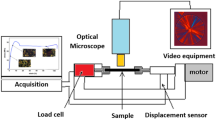Summary
The “Vickers” micro-indentation hardness of a series of melt crystallized polyethylene (PE), plastically deformed PE and melt crystallized paraffins was determined to establish correlations with superstructure, i. e. crystallite size, orientation and number of tie molecules. In 100% crystalline systems (paraffins) the penetration depth of the indenter is a hyperbolic decreasing function of crystal thickness,I, and extrapolates forl → ∞ to the experimentally indentation value obtained for high pressure crystallized PE (“extended chain crystals”). In the polymer case (two phase system) indentation depends on bothl and on amorphous content. Thus, for a givenl, PE shows, depending on crystallinity, higher indentation values than paraffins. The “amorphous” phase is related to the reversible loading time dependence of indentation which levels off to a characteristic limiting value. The time dependent behaviour of indentation vanishes either when the amorphous phase is removed by selective oxidative attack or when the polymer is plastically deformed at high deformations (λ>12) and the tie molecules in the amorphous layers and interfibrillar regions are highly strained. The change of microhardness as a function of draw ratio, λ, is discontinuous in support of the abrupt transformation from the original microspherulitic into the fibre structure according to the model of plastic deformation proposed byPeterlin (20, 21). The highly anisotropic fiber structure yields a conspicuously anisotropic shape of the indentation which can be explained by a recovery of the microfibrils parallel to the fibre axis. Finally, the increase of microhardness withλ, can be correlated to the increasing number of tie molecules in the fibrous structure.
Zusammenfassung
Es wurde die “Vickers” Mikrohärte (MH) einer Reihe von schmelzkristallisiertem und plastisch-deformiertem Polyäthylen (PÄ) und schmelzkristallisierten Paraffinen gemessen, um eine Korrelation mit der Überstruktur — Kristallitgröße, Orientierung und Zahl der “Tie Molecules” — zu bestimmen. Für eine 100% Kristallinität (Paraffine) ist die Eindringtiefe des Diamanten,d, eine hyperbolisch-abnehmende Funktion der Kristallitdicke,l. Für 1 → ∞ extrapoliert,d auf den erhaltenen experimentellen Wert für Hochdruck kristallisiertes PÄ (Extended Chain Crystals). Im Polymerfall (Zweiphasensystem) ist der Eindruck vonl und dem amorphen Anteil abhängig. Deshalb zeigt PÄ für einen beliebigen Wertl, abhängig von der Kristallinität, höhere Eindrücke als bei Paraffinen. Die amorphe Phase ist mit der reversiblen Ladezeitabhängigkeit des Eindrucks verbunden, die konstant bis zu einem charakteristischen Grenzwert ausläuft. Das zeitabhängige Verhalten des Eindrucks verschwindet entweder, indem man die amorphe Phase entfernt, durch Salpetersäure-Abbau oder wenn das Polymer hochdeformiert wird (λ > 12) und die “Tie Molecules” in den amorphen und interfibrillaren Bereichen hochgespannt sind. Die Änderung der MH als Funktion des Verstreckungsgrades, λ, ist diskontinuierlich in Übereinstimmung mit dem vonPeterlin (20, 21) vorgeschlagenen sprunghaften Übergang von der mikrospherulitischen zur Faserstruktur. Die Faserstruktur bildet eine typische anisotropische Form des Eindrucks, die man als eine elastische Erholung der Mikrofibrillen parallel zur Faserrichtung erklären kann. Letztlich kann man die Steigung der MH als Funktion von λ, mit der zunehmenden Zahl der “Tie Molecules” in der Faserstruktur korrelieren.
Similar content being viewed by others
References
Kuznetsov, V. D., Surface Energy of Solids, p. 44 (1957).
Lendvay, E. andM. V. Fock, J. Materials Sci.4, 747 (1969).
Brookes, C. A., J. B. O'Neill andB. A. Redfern, Proc. Roy. Soc. Lond.A322, 73 (1971).
Brookes, C. A., P. Green, P. H. Harrison andB. Moxley, J. Phys. D. Appl. Phys.5, 1284 (1972).
O'Neill, J. B. O., B. A. W. Redfern andC. A. Brookes, J. Materials Sci,8, 47 (1973).
Baltá Calléja, F. J., unpublished results.
Keller, A., Phil. Mag.6, 329 (1961).
Holzmüller, W. andK. Altenburg, Physik der Kunststoffe, p. 617 (1961);L. E. Nielsen, Mechanical Properties of Polymers, p. 220 (1965).
Racké, H. H. andT. Fett, Materialprüfung,13, 37 (1971).
Peterlin, A., Macromolecular Chemistry,8, 277 (1973).
Rueda, D. R., Private communication.
Hoffman, J. D. andJ. J. Weeks, J. Res. Nat. Bur. Stand.66 A, 13 (1962).
Baltá Calléja, F. J. andD. R. Rueda, Polymer J.,6, 216 (1974).
Čačković, H., J. Loboda Čačković, R. Hosemann andD. Weick, Colloid & Polymer Sci.252, 812 (1974).
Baltá Calléja, F. J. andA. Peterlin, J. Macromol Sci. Phys.B4 (3), 519 (1970).
Peterlin, A. andF. J. Baltá Calléja, Kolloid Z. u. Z. Polymere,242, 1093 (1970).
Meinel, G., N. Morosoff andA. Peterlin, J. Polymer Sci.A 2 (8), 1723 (1970).
Morosoff, N. andA. Peterlin, J. Polymer Sci.A2 (10), 1237 (1970).
Sakaoku, K. andA. Peterlin, J. Polymer Sci.A2 (9), 895 (1971).
Peterlin, A., J. Materials Sci.6, 490 (1971).
Peterlin, A., J. Macromol. Sci. Phys.B8, 83 (1973).
Peterlin, A., Polymer Eng. and Sci.,14, 627 (1974).
Perry, A. J. andD. J. Rowcliffe, J. Materials Sci.8, 904 (1973).
Meinel, G. andA. Peterlin, J. Polymer Sci.9, 67 (1971).
Peterlin, A., Kolloid Z. and Z. Polymere,233, 858 (1969).
Hosemann, R., J. Loboda-Čačković andH. Čačko-vić, Z. Naturforsch.27a, 478 (1972).
Loboda-Čačković, J. andH. Caćković, Kolloid-Z. u. Z. Polymere250, 511 (1972).
Hosemann, R., Polymer3, 349 (1962).
Author information
Authors and Affiliations
Rights and permissions
About this article
Cite this article
Baltá-Calleja, F.J. Dependence of micro-indentation hardness on the superstructure of polyethylene. Colloid & Polymer Sci 254, 258–266 (1976). https://doi.org/10.1007/BF01384024
Received:
Issue Date:
DOI: https://doi.org/10.1007/BF01384024




